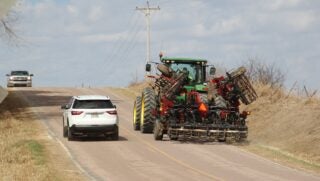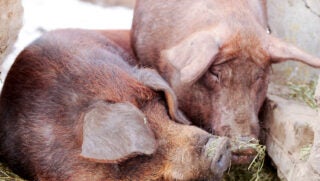The New England strawberry season can now be marked from mid-July all the way through Thanksgiving, after researchers with the New Hampshire Agricultural Experiment Station at the University of New Hampshire succeeded in quadrupling the length of the Granite State’s strawberry growing season.
New Hampshire’s strawberry season traditionally lasts only four to six weeks. However, researchers working on the multi-state TunnelBerries project were picking day-neutral strawberries in Durham last November. Last year, researchers harvested strawberries grown in low tunnels for 19 consecutive weeks from mid-July through the week of Thanksgiving. They also found that the low tunnels significantly increased the percentage of marketable fruit, from an average of about 70 percent to 83 percent.
Now in its second year, the TunnelBerries research project is being conducted at the UNH Woodman Horticultural Research Farm. It is part of a larger, multi-state USDA-funded initiative to optimize protected growing environments for berry crops in the upper Midwest and northeastern United States. UNH’s component is focused on improving berry quality and the role day-neutral varieties may play in extending the length of strawberry season in the Northeast.
“Most New Englanders look forward to strawberry season because regionally produced strawberries are delicious,” said graduate student Kaitlyn Orde, who is working with experiment station researcher Becky Sideman on the project. “They also are a very valuable early season crop for farmers throughout the region. Unfortunately, though, this season is very brief, limiting the period in which our regional producers are able to meet consumer demand for the fresh fruit. A longer strawberry season is good for both grower and consumer.”
Sideman, an associate professor of plant biology and Cooperative Extension professor and specialist in sustainable horticulture production, estimates the retail value of New Hampshire’s strawberry crops at about $1.85 million, which she says is a conservative estimate.
The UNH project consists of two parts. Researchers want to determine the yield and fruiting duration of day-neutral strawberry varieties. Day-neutrals are a different plant-type than the traditional June-bearers most common in New Hampshire; day-neutrals (or ever-bearing) have been shown to fruit continuously for four to six months in the region. In addition, day-neutrals fruit the same year they are planted, which is not the case with June-bearers.
“We are growing one day-neutral variety on three different mulches to determine if there are any differences in total production, production patterns, runner production, and fruit characteristics among the mulches,” Orde said. “We also are investigating the role plastic covered low-tunnels play in improving berry quality, and what the microenvironment is within low tunnels, especially late season. To do this, we are evaluating five different plastics for the low tunnels.”
Researchers in Maryland, Minnesota, North Carolina, and New York have conducted preliminary research on similar systems. There also are limited growers in the Northeast who already cultivate day-neutral varieties, and even fewer who have experimented with low-tunnels in combination with the strawberry crop. However, there are no yield estimates or material recommendations, such as mulch or low tunnel cover, for New Hampshire producers.


